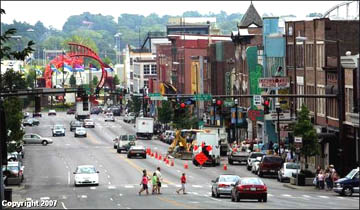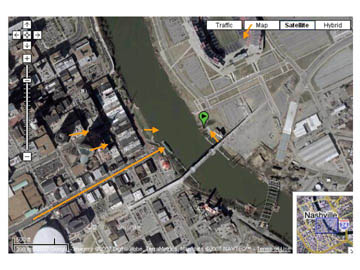After my rant on the failure of public art to find a home in valuable, visible places, the City of Nashville has the guts to hire Alice Aycock with its first artwork and site it on the Cumberland River. Not any location, but at the terminus of an important historic street, under the shadow of the Titans football stadium and in plain view of every river boat and corporate window in downtown Nashville.
Urbanisticly, the work succeeds from many places and helps make the connection between the high city and industrial flood plain. On axis with Broadway, the broken red steel crescents form a bull’s eye with a swilling double top-like thing in the middle – a clear graphic artwork from the material of industry. From the riverbank and bridges, the work is a mess of metal that vertically defines the edge of bank and appears invisibly stopped from moving toward the high city – a psychological movement of rejection. From the river walk looking up through the sculpture, the work beautifies the memory of lightweight steel structures of warehouses and bridges.

100 x 100 foot sculpture fills the Broadway view. Photo Larry McCormick / The Tennessean
More than Aycock’s other works, I think the sculpture will attract amateur photographers – an essential element of the successful public art. Flickr pictures show the interest in detailed “artistic” photos through the open struts.
I don’t know if it is a comment on the polite quality of southern newspapers or the work itself, but an intelligent debate has been sponsored and supported by the Tennessean. On Saturday, August 4th, the Tennessean Newspaper Editorial Board supported the first major public artwork in Nashville. The paper also ran reader opinions, a public art board member and a libertarian who argued that government sponsorship of art is bad for the art. In July, the Tennessean ran a comprehensive news story with good photos.

Excellent visual civic location. On axis with Broadway. Tower views. Stadium Views. River Views.
Metro Nashville Arts Commission is the agency managing the project.
On line at my day job google site is a powerpoint presentation on “What is an Icon?” At the end of the images, you can see the four of the competition entries from Aycock, Carpenter, Sayre and Openheim.
Public Art, Public Space
